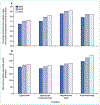Inappropriate opioid prescription after surgery
- PMID: 30983590
- PMCID: PMC6556783
- DOI: 10.1016/S0140-6736(19)30428-3
Inappropriate opioid prescription after surgery
Abstract
Worldwide, the use of prescription opioid analgesics more than doubled between 2001 and 2013, with several countries, including the USA, Canada, and Australia, experiencing epidemics of opioid misuse and abuse over this period. In this context, excessive prescribing of opioids for pain treatment after surgery has been recognised as an important concern for public health and a potential contributor to patterns of opioid misuse and related harm. In the second paper in this Series we review the evolution of prescription opioid use for pain treatment after surgery in the USA, Canada, and other countries. We summarise evidence on the extent of opioid overprescribing after surgery and its potential association with subsequent opioid misuse, diversion, and the development of opioid use disorder. We discuss evidence on patient, physician, and system-level predictors of excessive prescribing after surgery, and summarise recent work on clinical and policy efforts to reduce such prescribing while ensuring adequate pain control.
Copyright © 2019 Elsevier Ltd. All rights reserved.
Figures

Comment in
-
Optimal postoperative pain management: redefining the role for opioids.Lancet. 2019 Apr 13;393(10180):1483-1485. doi: 10.1016/S0140-6736(19)30854-2. Lancet. 2019. PMID: 30983573 No abstract available.
References
-
- Berterame S, Erthal J, Thomas J, et al. Use of and barriers to access to opioid analgesics: a worldwide, regional, and national study. Lancet 2016; 387: 1644–56. - PubMed
-
- Okie S A flood of opioids, a rising tide of deaths. N Engl J Med 2010; 363: 1981–85. - PubMed
-
- Fischer B, Argento E. Prescription opioid related misuse, harms, diversion and interventions in Canada: a review. Pain Physician 2012; 15 (suppl 3): 191–203. - PubMed
-
- Larance B, Degenhardt L, Peacock A, et al. Pharmaceutical opioid use and harm in Australia: the need for proactive and preventative responses. Drug Alcohol Rev 2018; 37 (suppl 1): s203–05. - PubMed
-
- Winstock AR, Borschmann R, Bell J. The non-medical use of tramadol in the UK: findings from a large community sample. Int J Clin Pract 2014; 68: 1147–51. - PubMed
Publication types
MeSH terms
Substances
Grants and funding
LinkOut - more resources
Full Text Sources
Medical

